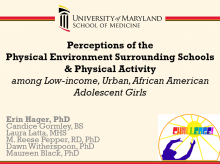We are pleased to announce an exciting new alliance between Active Living Research and GP RED to co-host and coordinate...
Perceptions of the Physical Environment Surrounding Schools and Physical Activity among Low-Income, Urban, African American Adolescent Girls

Presentation at the 2012 Active Living Research Annual Conference.
View the associated research paper.
Background
Low-income, urban, African American adolescent girls experience very low rates of physical activity and high rates of obesity, demonstrating the importance of identifying mechanisms for increasing physical activity in this high risk population. Positive perceptions of the physical environment near the homes of adolescent girls have been associated with higher levels of physical activity, however perceptions of the physical environment surrounding schools have not been examined.
Objectives
To examine the relationship between adolescent girls’ perceptions of the physical environment surrounding their schools and their objectively measured physical activity. It is hypothesized that adolescent girls with a positive perception of the environment surrounding their school will be more active than girls with a less positive perception.
Methods
A sample of 293 6th and 7th grade girls from 12 low-income, urban, predominantly African American middle schools were recruited to participate in an obesity prevention trial and given an Actical accelerometer (Phillips Respironics, Inc.) to wear on their ankle for >7 consecutive days to assess physical activity. The first and last days of data were truncated and up to 7 full days of data were retained. Minutes in moderate-vigorous physical activity (min-MVPA) were determined using a previously validated cut-off of 3200 counts/minute. Body composition was assessed by calculating BMI-for-age percentiles from height and weight measured in triplicate. Questionnaires were administered using audio enhanced computer-assisted software. Perception of the physical environment around the school was measured using a 10-item questionnaire (Evenson et al. 2007) addressing safety, aesthetics, and access to physical activity facilities. This Perceptions of the Physical Environment Questionnaire (PPEQ) was adapted by changing the phrase “near your home” to “near your school”. The PPEQ was analyzed using a mean score. Schools were dichotomized by median PPEQ score across participants (more positive versus less positive). Spearman correlations were used to determine the bivariate relationship between PPEQ and min-MVPA. T-tests were employed to examine mean differences in PPEQ and min-MVPA by grouping variables. Linear regression models were conducted to determine the relationship between perceptions and physical activity controlling for covariates.
Results
Of the 293 adolescents who were recruited and given an accelerometer, 236 (80.5%) had valid physical activity data. Of these 236, 92.8% answered the PPEQ, for a final sample size of 219 adolescent girls. The 12 schools were located in urban neighborhoods and had populations that were, on average, 89.2% African American and 71.9% receiving free/reduced price lunch. The mean age of the girls was 12.1 years (range 10.5-14.4), 82.9% were African American, 55.3% were in the 6th grade, and 44.0% were overweight or obese. The mean PPEQ score was 3.45 (range 1.2-5.0, Cronbach’s alpha = 0.61). Accelerometers were worn for an average of 5.8 days (range 2-7), and recorded an average of 34.7 min-MVPA each day (range 0-99.7). Bivariate analyses revealed no association between PPEQ and min-MVPA. Graphing mean PPEQ scores by school revealed a distinct difference in perceptions among the 12 schools, leading to grouping schools into 2 categories based on median PPEQ: more positive perceptions (6 schools, mean PPEQ= 3.7), less positive perceptions (6 schools, mean PPEQ=3.3), t=-4.3, p<0.001). Linear regression analyses revealed that adolescent girls in schools with more positive perceptions of the environment engaged in fewer min-MVPA compared to girls in schools with less positive perceptions (beta=-0.689, p=0.005), controlling for age, weight status, and race. Girls in schools with more positive perceptions of the environment engaged in 30.3 min-MVPA compared to 37.7 min-MVPA among girls in schools with less positive perceptions (t=3.07, p=0.002).
Conclusions
The hypothesis set forth at the beginning of this study was not supported. The reverse, girls attending schools with more positive perceptions of the physical environment around the schools were significantly less active compared to girls with less positive perceptions, was supported. These findings suggest that perceptions of the physical environment surrounding schools, including safety, aesthetics, and access to physical activity facilities, may not be enough to overcome other barriers to engaging in physical activity among low-income, urban, predominantly African American adolescent girls. Additional research is needed to understand what factors in addition to perceptions of the physical environment around schools are related to the physical activity of this at-risk population. Such research should include an examination of the built environment in the neighborhood surrounding schools and its’ role in promoting physical activity among school-aged children. Focusing research on the neighborhood surrounding schools could have far-reaching policy implications, as policy makers have the ability to enact zoning laws near public schools that could influence the built environment.
Support/Funding
RWJF ALR/New Connections Grant #65631 and NIH R01HD054727.
- DOWNLOAD "2012_PAInAroundSchools_Hager.pdf" PDF (0.93 MB) Presentations
Related Tools & Resources
STAY UP TO DATE
RECENTLY ADDED TOOLS & RESOURCES
MOVE! A BLOG ABOUT ACTIVE LIVING
The "Active Living Conference" aims to break down research and practice silos and...







